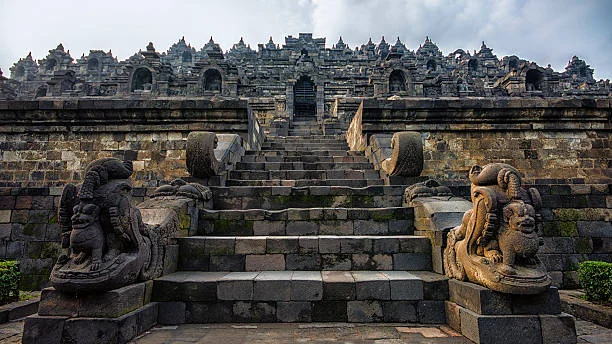There are a large number of Buddhist temples in the world. Most of them are located in Asian countries. The largest of them is considered to be the Borobudur temple situated in Indonesia.
One of the first places where Buddhism emerged after India was Indonesia. Today on the territory of this country are some of the oldest monuments of Buddhism. One of them is the Borobudur Temple, located on the island of Java in Indonesia. 15 kilometers from the city of Magelang in the central part of Java.
Description of the temple

Today this temple is the largest Buddhist monument in the world. In addition, Borobudur is considered the tallest Buddhist stupa globally, bypassing the famous Kesariya stupa in India. The height of the Kesariya stupa is about 31.5 meters, and the height of the Borobudur stupa is about 34 meters.
The Borobudur foundation is square, with a long side of 123 meters. The temple consists of eight tiers. The bottom five are square, and the other three are round. This form reflects the schema of the worldview according to the ideas of Buddhist monks.
On the upper tier, 72 small stupas surround the large central stupa. Each of them is made in the form of an ornate bell. Inside them are Buddha statues.
All the walls and terraces of the temple are covered with incredible and intricate bas-reliefs that reflect the teachings of the Buddha. The central stupa is a symbol of dedication to Buddha – a symbol of eternity and enlightenment.
Borobudur in religion
Even now, Borobudur remains a place of religious pilgrimage and prayer. Pilgrims walk around each tier seven times clockwise. However, only Buddhist monks are allowed to enter through the central stupa.
Researchers believe that this structure can be considered a huge book for pilgrims.
Passing, according to the ritual, each tier, believers get acquainted with the life and teachings of the Buddha. According to history, if you touch everyone located in the stupa of the upper tier, the Buddha through a recess in it will bring happiness. However, some stupas turn out to be empty (as you remember, there are no 43 statues out of 504). And one, a special stupa, symbolizes the dwelling of the Buddha. If you touch the foot of the Buddha in it, then according to history, your desire will certainly come true.
When the temple was built
Borobudur was built about 1200 years ago. During this time, it experienced the eruption of Mount Merapi and a change of religion on the island of Java and even a change in the country’s political course. At the same time, even after visiting treasure hunters, the temple managed to preserve its beautiful and monumental appearance.
Borobudur Temple is one of the largest Buddhist monuments on the planet. It was built between about 750-850 AD. According to scientists, its construction took at least 100 years.
The oblivion of Borobudur Temple
For a long time, Borobudur was desolate, covered with volcanic ash.
What led to the desolation of this unique monument, for what reasons it was abandoned, remains a mystery.
Around the middle of the 20th century, historians assumed that the misfortune that befell the inhabitants after the eruption of Merapi forced them to leave their homes in search of a new place to live. The volcano erupted in 1006. However, many scientists believe that the shift of the center of Javanese civilization to the Brantas Valley occurred earlier, in about 928. And yet, the true reason why the residents left Borobudur remains unknown.
Rediscovery and recovery
The temple was rediscovered in 1814 when the island was occupied by the British. During an expedition organized by them, consisting of 200 people, the monument was cleaned for a month and a half. Later, other researchers continued their work. The upper part of the monument was completely cleared in 1835. Since then, the entire complex has become visible.
In those days, the monuments were actively plundered. Sculptures, bas-reliefs, ornaments were taken away by thieves for souvenirs. Only one king of Siam, after visiting the governor of the island of Java in 1886, took out statues, elements, and ornaments on eight bull sleds. Among them was the only surviving sculpture of the temple keeper. As a result of such looting and natural destruction, the temple was severely damaged.
But the temple has been restored several times. The largest restoration took place from 1975 to 1982. Since then, Borobudur has been included in the UNESCO World Heritage List. The Borobudur temple has been completely restored, the hill has been fortified, and an irrigation system has been built.
Borobudur temple in tourism
Borobudur is the most visited attraction in Indonesia.
In 1974, 260,000 tourists visited the temple. Of these, 36,000 were foreigners. And in the mid-1990s, this figure rose to 2.5 million people.
200 meters from the temple, there is the 3-star Manohara Borobudur Hotel. The temple has several tourism awards. In June 2012, Borobudur was included in the Guinness Book of Records as the site of the largest archaeological site in the Buddhist world.
The large influx of visitors climbing the narrow stairs of Borobudur caused severe wear and tear on the stone steps. To avoid further deterioration of the stairs, since November 2014, two main sections of Borobudur stairs – east (upward) and north (downward) – have been covered with wooden structures. A similar technique is used in Angkor Wat in Cambodia and the Egyptian pyramids.
In addition, there were proposals to cover the stairs with a rubber cover or to provide visitors with special shoes. However, for the time being, they manage with a wooden covering of the stairs
